Case Study on Taxation Law: Income, Deductions, and Residency Status
VerifiedAdded on 2023/06/12
|12
|2204
|258
Case Study
AI Summary
This assignment presents a comprehensive case study on taxation law, divided into two parts. The first part involves calculating Dale's taxable income, considering cash receipts, trading stock, wages, rent, and other business expenses. It applies Section 8-1 of the Income Tax Assessment Act 1997 (ITAA 1997) to determine allowable deductions for expenses like lease renewal, superannuation guarantee, telephone, electricity, and insurance. The analysis also addresses the Medicare levy and provides a final calculation of net tax payable. The second part focuses on determining Amity's residency status for tax purposes, examining the Domicile Test, 183 days' test, Ordinary Concept Test, and Superannuation Test. It references relevant case law, such as Applegate v Federal Commissioner of Taxation (1979), to conclude whether Amity is considered an Australian resident under the ITAA 1936 and Domicile Act 1982.
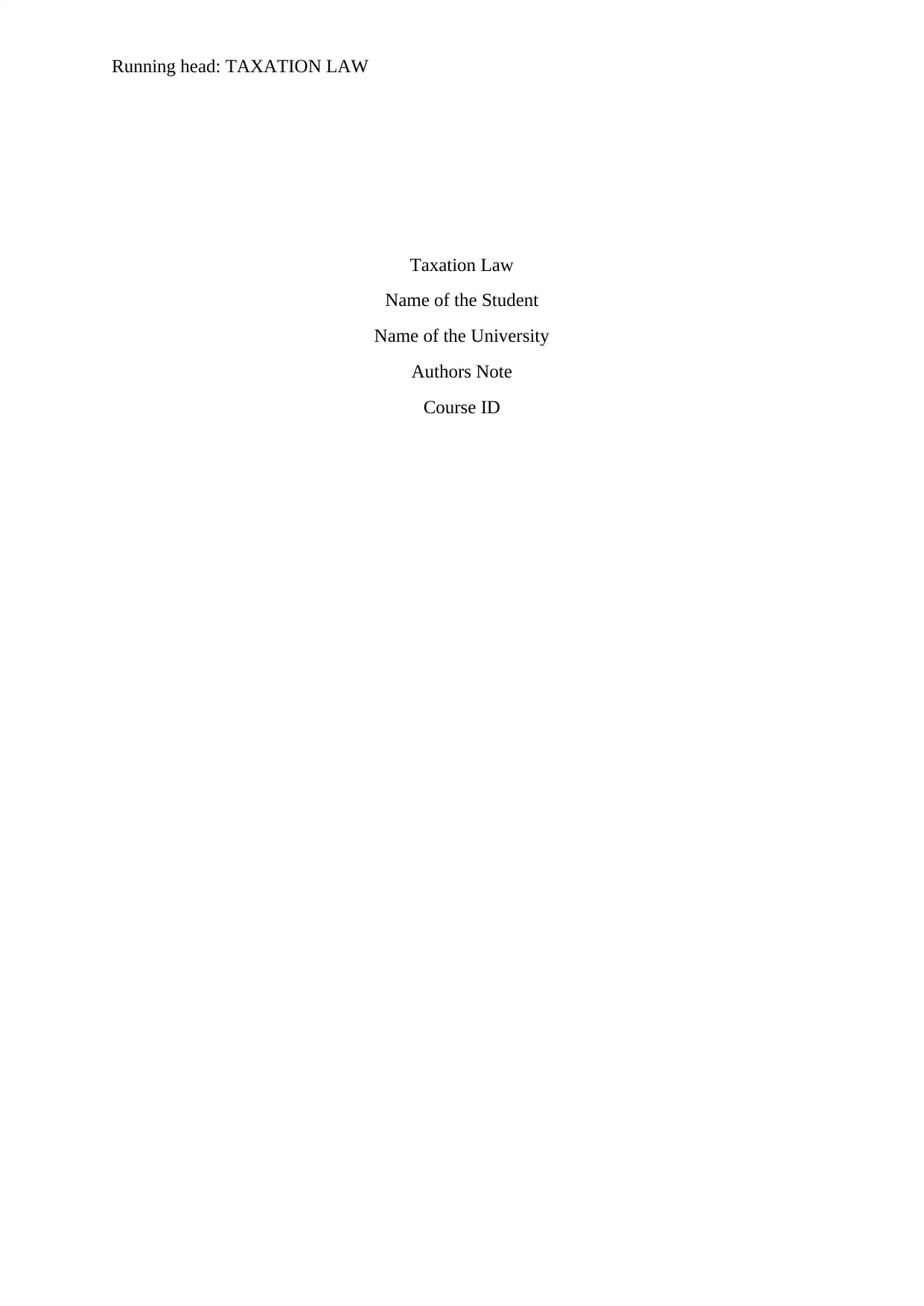
Running head: TAXATION LAW
Taxation Law
Name of the Student
Name of the University
Authors Note
Course ID
Taxation Law
Name of the Student
Name of the University
Authors Note
Course ID
Paraphrase This Document
Need a fresh take? Get an instant paraphrase of this document with our AI Paraphraser
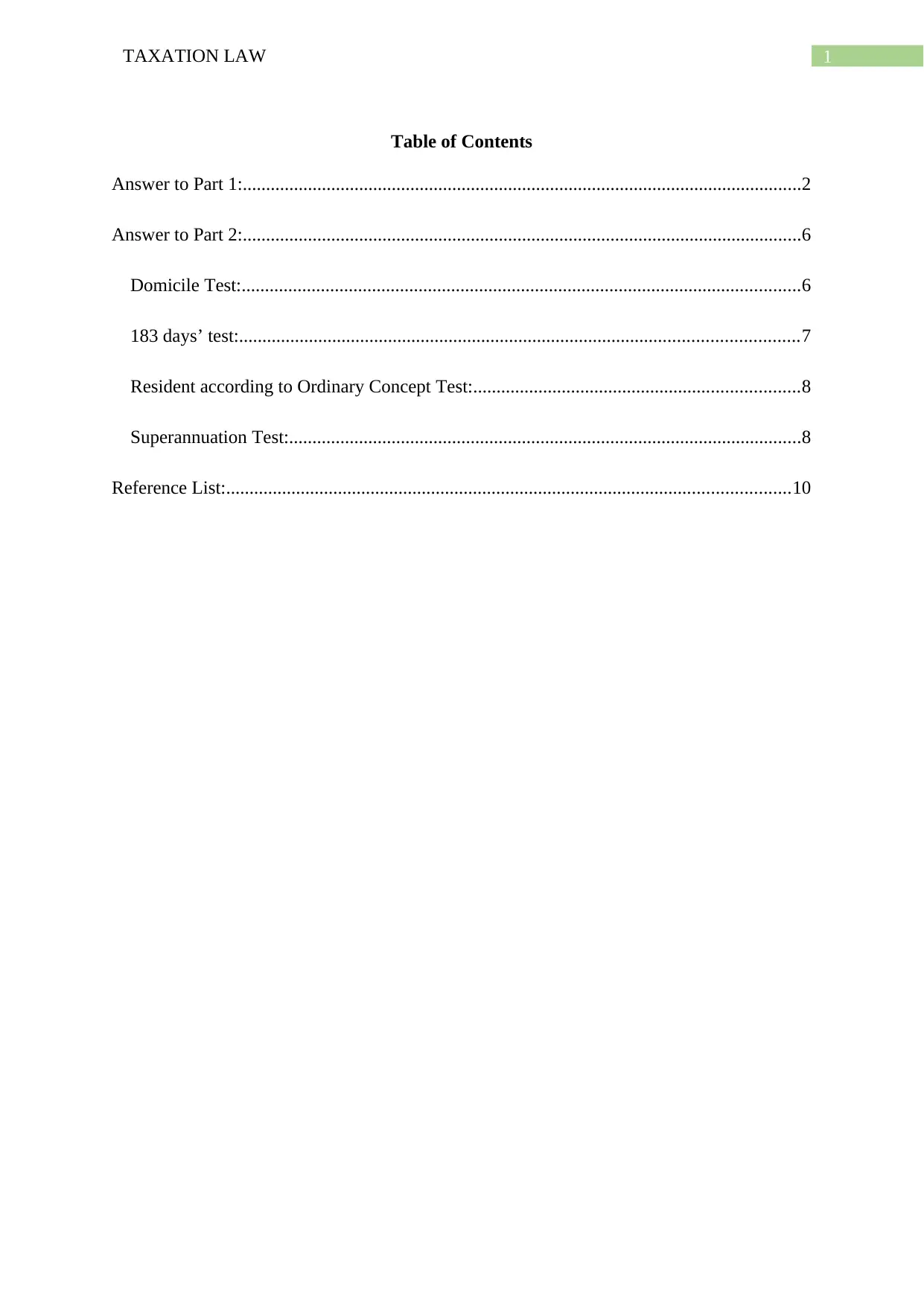
1TAXATION LAW
Table of Contents
Answer to Part 1:........................................................................................................................2
Answer to Part 2:........................................................................................................................6
Domicile Test:........................................................................................................................6
183 days’ test:........................................................................................................................7
Resident according to Ordinary Concept Test:......................................................................8
Superannuation Test:..............................................................................................................8
Reference List:.........................................................................................................................10
Table of Contents
Answer to Part 1:........................................................................................................................2
Answer to Part 2:........................................................................................................................6
Domicile Test:........................................................................................................................6
183 days’ test:........................................................................................................................7
Resident according to Ordinary Concept Test:......................................................................8
Superannuation Test:..............................................................................................................8
Reference List:.........................................................................................................................10
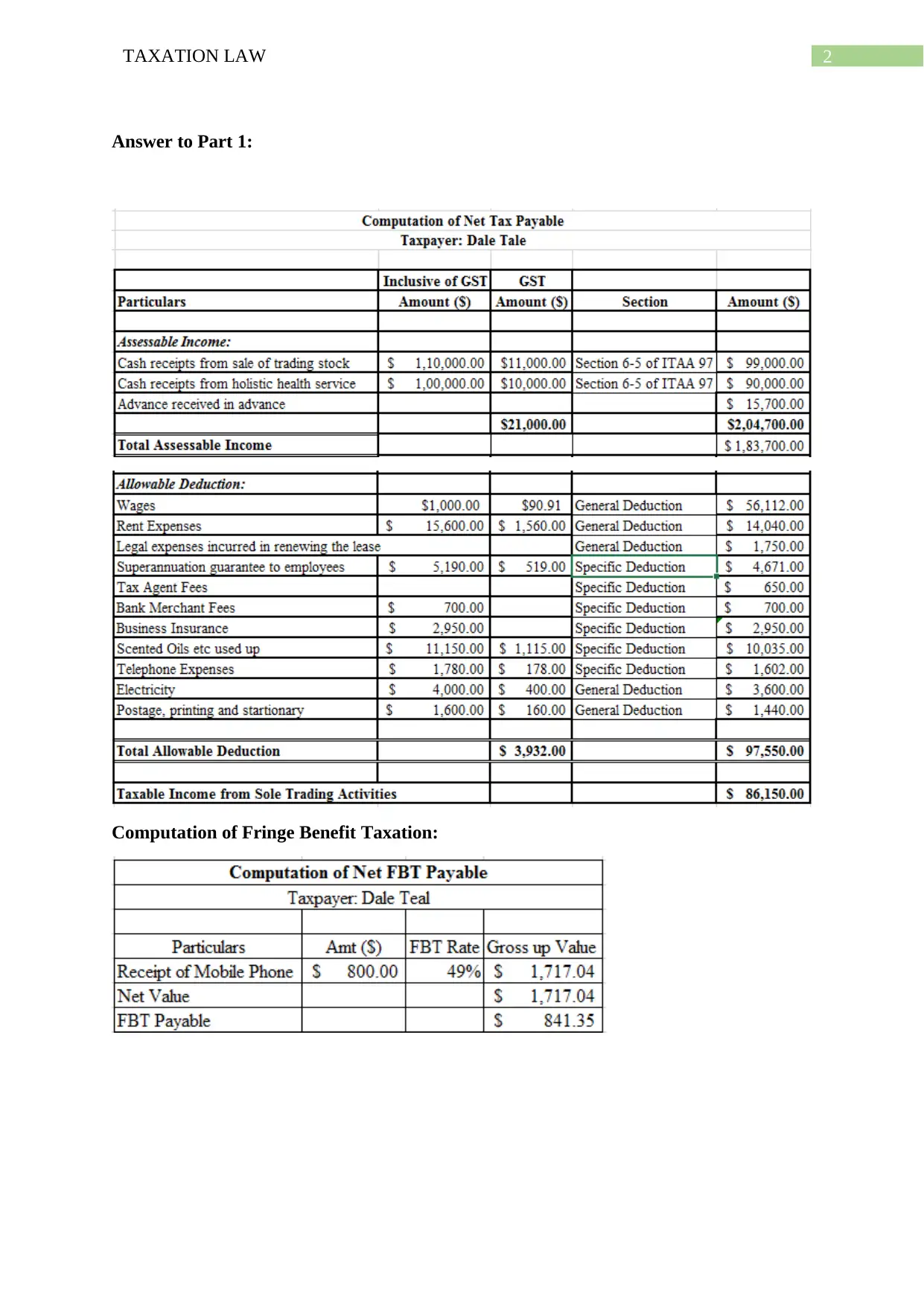
2TAXATION LAW
Answer to Part 1:
Computation of Fringe Benefit Taxation:
Answer to Part 1:
Computation of Fringe Benefit Taxation:
⊘ This is a preview!⊘
Do you want full access?
Subscribe today to unlock all pages.

Trusted by 1+ million students worldwide
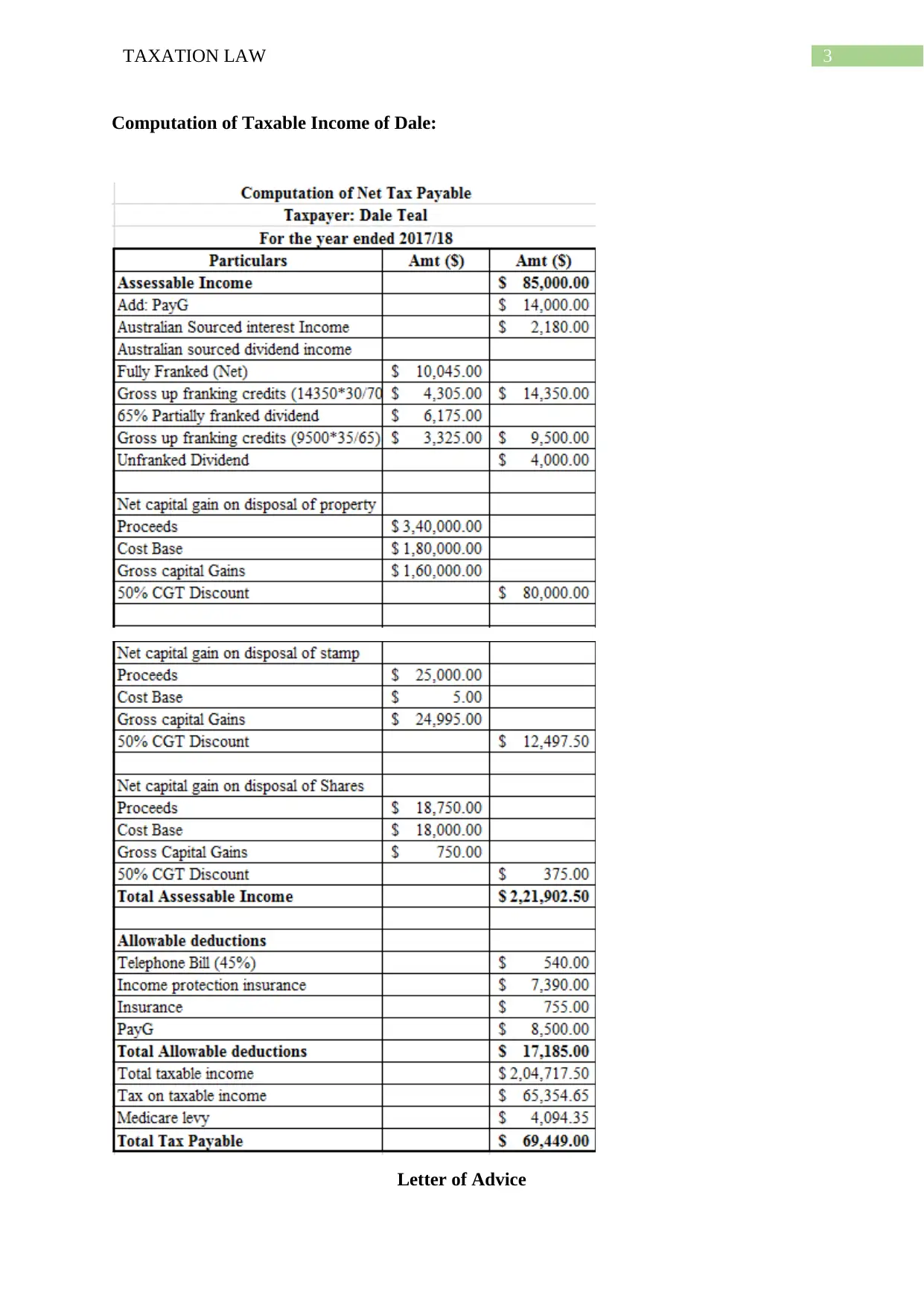
3TAXATION LAW
Computation of Taxable Income of Dale:
Letter of Advice
Computation of Taxable Income of Dale:
Letter of Advice
Paraphrase This Document
Need a fresh take? Get an instant paraphrase of this document with our AI Paraphraser
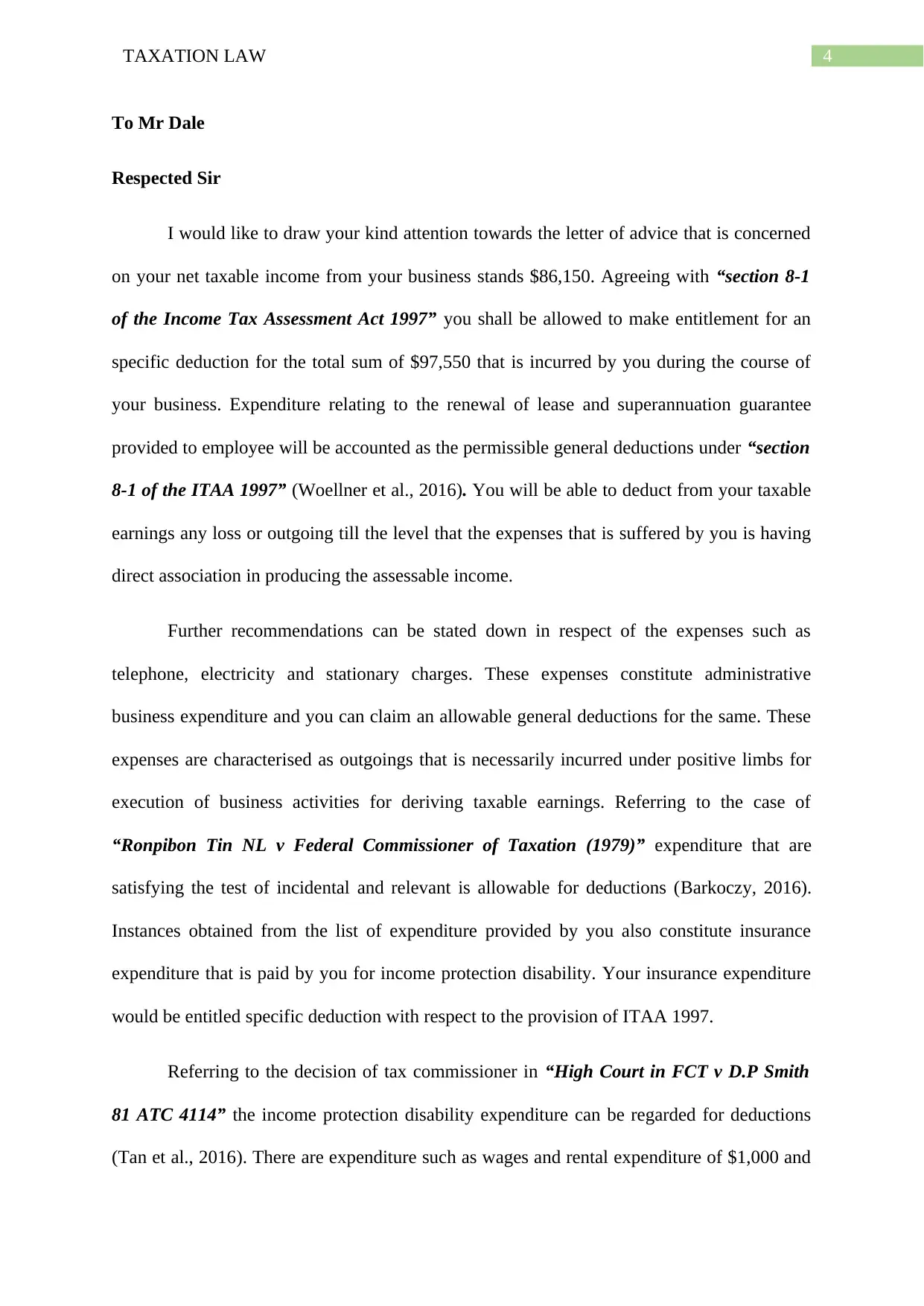
4TAXATION LAW
To Mr Dale
Respected Sir
I would like to draw your kind attention towards the letter of advice that is concerned
on your net taxable income from your business stands $86,150. Agreeing with “section 8-1
of the Income Tax Assessment Act 1997” you shall be allowed to make entitlement for an
specific deduction for the total sum of $97,550 that is incurred by you during the course of
your business. Expenditure relating to the renewal of lease and superannuation guarantee
provided to employee will be accounted as the permissible general deductions under “section
8-1 of the ITAA 1997” (Woellner et al., 2016). You will be able to deduct from your taxable
earnings any loss or outgoing till the level that the expenses that is suffered by you is having
direct association in producing the assessable income.
Further recommendations can be stated down in respect of the expenses such as
telephone, electricity and stationary charges. These expenses constitute administrative
business expenditure and you can claim an allowable general deductions for the same. These
expenses are characterised as outgoings that is necessarily incurred under positive limbs for
execution of business activities for deriving taxable earnings. Referring to the case of
“Ronpibon Tin NL v Federal Commissioner of Taxation (1979)” expenditure that are
satisfying the test of incidental and relevant is allowable for deductions (Barkoczy, 2016).
Instances obtained from the list of expenditure provided by you also constitute insurance
expenditure that is paid by you for income protection disability. Your insurance expenditure
would be entitled specific deduction with respect to the provision of ITAA 1997.
Referring to the decision of tax commissioner in “High Court in FCT v D.P Smith
81 ATC 4114” the income protection disability expenditure can be regarded for deductions
(Tan et al., 2016). There are expenditure such as wages and rental expenditure of $1,000 and
To Mr Dale
Respected Sir
I would like to draw your kind attention towards the letter of advice that is concerned
on your net taxable income from your business stands $86,150. Agreeing with “section 8-1
of the Income Tax Assessment Act 1997” you shall be allowed to make entitlement for an
specific deduction for the total sum of $97,550 that is incurred by you during the course of
your business. Expenditure relating to the renewal of lease and superannuation guarantee
provided to employee will be accounted as the permissible general deductions under “section
8-1 of the ITAA 1997” (Woellner et al., 2016). You will be able to deduct from your taxable
earnings any loss or outgoing till the level that the expenses that is suffered by you is having
direct association in producing the assessable income.
Further recommendations can be stated down in respect of the expenses such as
telephone, electricity and stationary charges. These expenses constitute administrative
business expenditure and you can claim an allowable general deductions for the same. These
expenses are characterised as outgoings that is necessarily incurred under positive limbs for
execution of business activities for deriving taxable earnings. Referring to the case of
“Ronpibon Tin NL v Federal Commissioner of Taxation (1979)” expenditure that are
satisfying the test of incidental and relevant is allowable for deductions (Barkoczy, 2016).
Instances obtained from the list of expenditure provided by you also constitute insurance
expenditure that is paid by you for income protection disability. Your insurance expenditure
would be entitled specific deduction with respect to the provision of ITAA 1997.
Referring to the decision of tax commissioner in “High Court in FCT v D.P Smith
81 ATC 4114” the income protection disability expenditure can be regarded for deductions
(Tan et al., 2016). There are expenditure such as wages and rental expenditure of $1,000 and
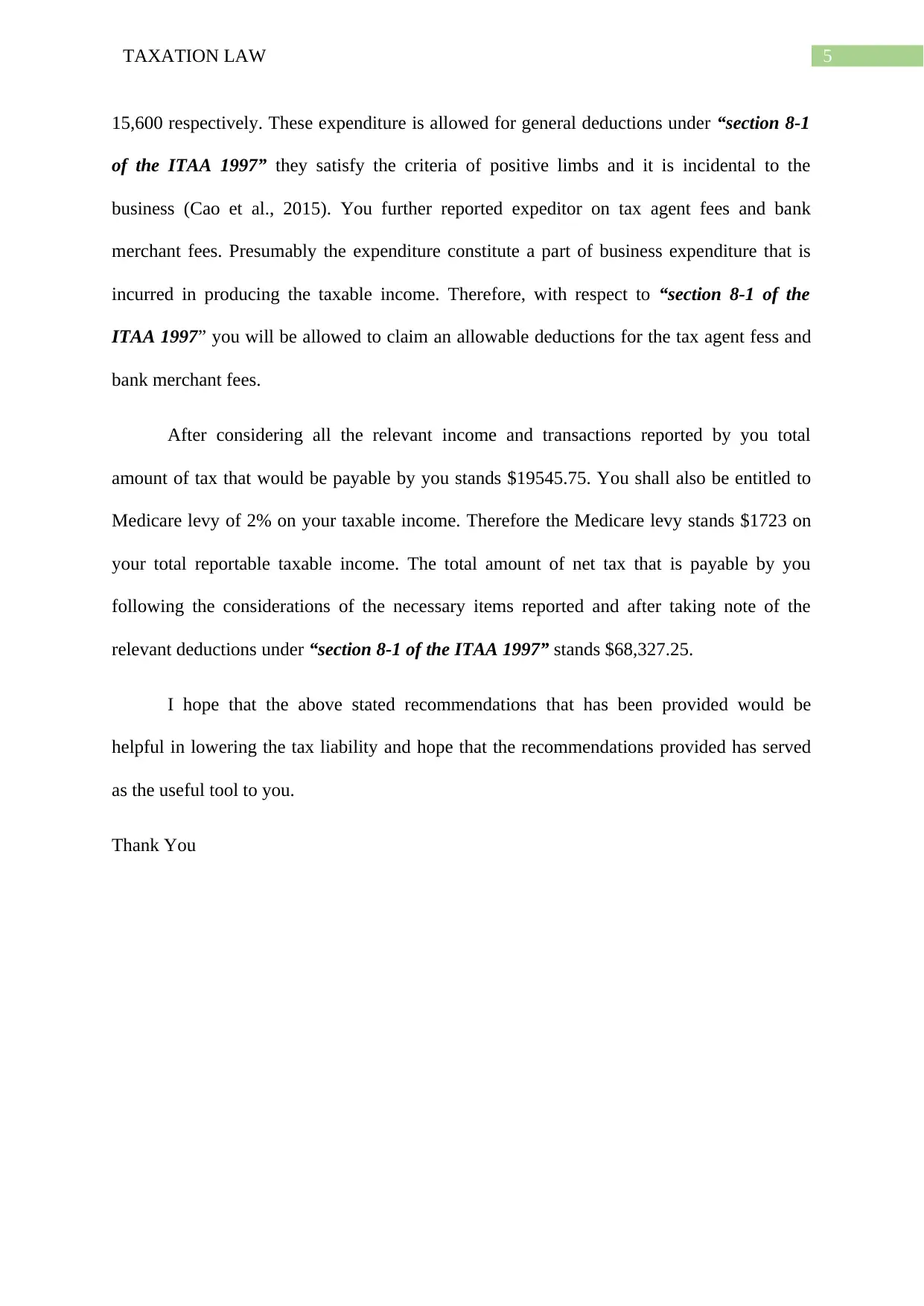
5TAXATION LAW
15,600 respectively. These expenditure is allowed for general deductions under “section 8-1
of the ITAA 1997” they satisfy the criteria of positive limbs and it is incidental to the
business (Cao et al., 2015). You further reported expeditor on tax agent fees and bank
merchant fees. Presumably the expenditure constitute a part of business expenditure that is
incurred in producing the taxable income. Therefore, with respect to “section 8-1 of the
ITAA 1997” you will be allowed to claim an allowable deductions for the tax agent fess and
bank merchant fees.
After considering all the relevant income and transactions reported by you total
amount of tax that would be payable by you stands $19545.75. You shall also be entitled to
Medicare levy of 2% on your taxable income. Therefore the Medicare levy stands $1723 on
your total reportable taxable income. The total amount of net tax that is payable by you
following the considerations of the necessary items reported and after taking note of the
relevant deductions under “section 8-1 of the ITAA 1997” stands $68,327.25.
I hope that the above stated recommendations that has been provided would be
helpful in lowering the tax liability and hope that the recommendations provided has served
as the useful tool to you.
Thank You
15,600 respectively. These expenditure is allowed for general deductions under “section 8-1
of the ITAA 1997” they satisfy the criteria of positive limbs and it is incidental to the
business (Cao et al., 2015). You further reported expeditor on tax agent fees and bank
merchant fees. Presumably the expenditure constitute a part of business expenditure that is
incurred in producing the taxable income. Therefore, with respect to “section 8-1 of the
ITAA 1997” you will be allowed to claim an allowable deductions for the tax agent fess and
bank merchant fees.
After considering all the relevant income and transactions reported by you total
amount of tax that would be payable by you stands $19545.75. You shall also be entitled to
Medicare levy of 2% on your taxable income. Therefore the Medicare levy stands $1723 on
your total reportable taxable income. The total amount of net tax that is payable by you
following the considerations of the necessary items reported and after taking note of the
relevant deductions under “section 8-1 of the ITAA 1997” stands $68,327.25.
I hope that the above stated recommendations that has been provided would be
helpful in lowering the tax liability and hope that the recommendations provided has served
as the useful tool to you.
Thank You
⊘ This is a preview!⊘
Do you want full access?
Subscribe today to unlock all pages.

Trusted by 1+ million students worldwide
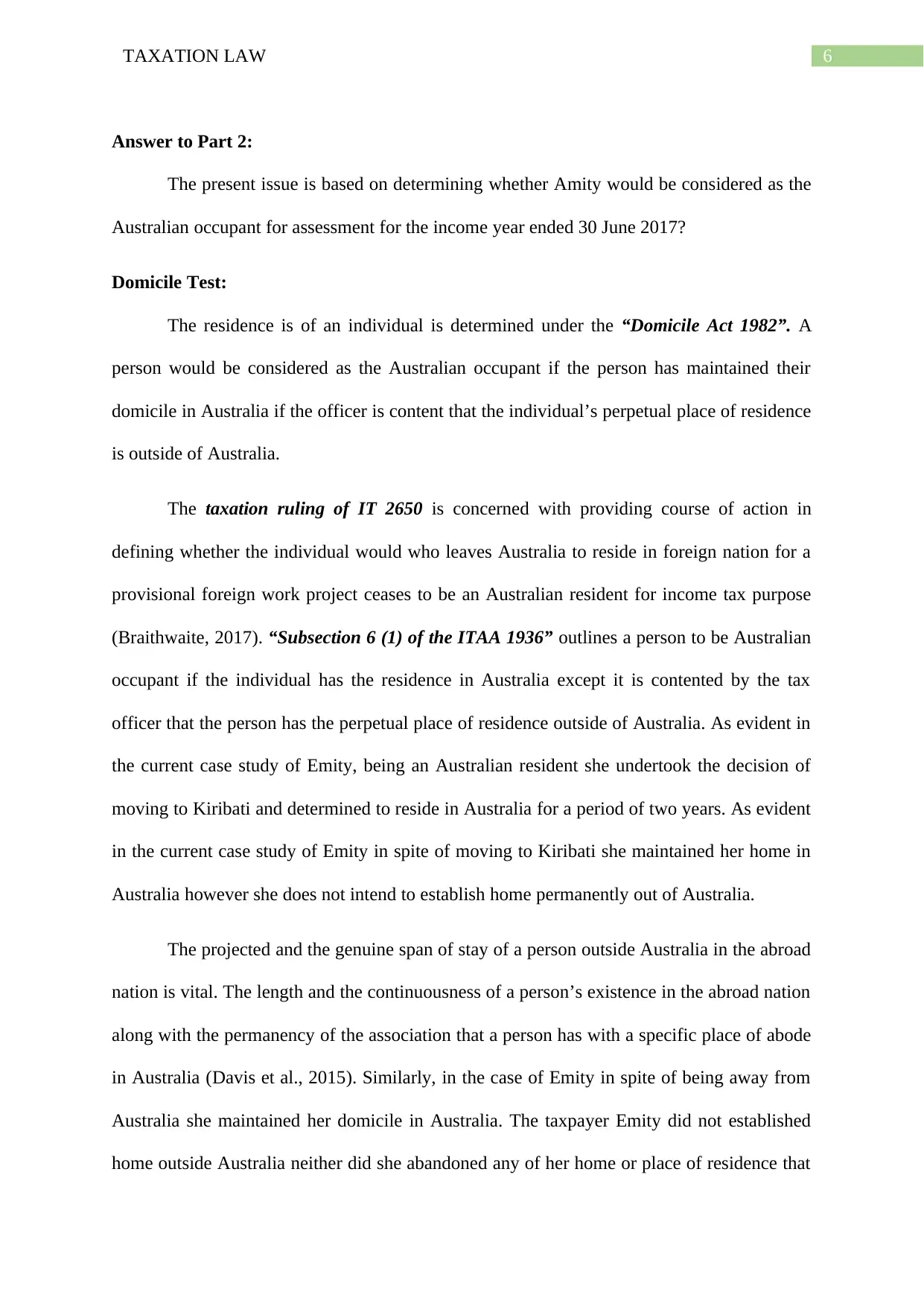
6TAXATION LAW
Answer to Part 2:
The present issue is based on determining whether Amity would be considered as the
Australian occupant for assessment for the income year ended 30 June 2017?
Domicile Test:
The residence is of an individual is determined under the “Domicile Act 1982”. A
person would be considered as the Australian occupant if the person has maintained their
domicile in Australia if the officer is content that the individual’s perpetual place of residence
is outside of Australia.
The taxation ruling of IT 2650 is concerned with providing course of action in
defining whether the individual would who leaves Australia to reside in foreign nation for a
provisional foreign work project ceases to be an Australian resident for income tax purpose
(Braithwaite, 2017). “Subsection 6 (1) of the ITAA 1936” outlines a person to be Australian
occupant if the individual has the residence in Australia except it is contented by the tax
officer that the person has the perpetual place of residence outside of Australia. As evident in
the current case study of Emity, being an Australian resident she undertook the decision of
moving to Kiribati and determined to reside in Australia for a period of two years. As evident
in the current case study of Emity in spite of moving to Kiribati she maintained her home in
Australia however she does not intend to establish home permanently out of Australia.
The projected and the genuine span of stay of a person outside Australia in the abroad
nation is vital. The length and the continuousness of a person’s existence in the abroad nation
along with the permanency of the association that a person has with a specific place of abode
in Australia (Davis et al., 2015). Similarly, in the case of Emity in spite of being away from
Australia she maintained her domicile in Australia. The taxpayer Emity did not established
home outside Australia neither did she abandoned any of her home or place of residence that
Answer to Part 2:
The present issue is based on determining whether Amity would be considered as the
Australian occupant for assessment for the income year ended 30 June 2017?
Domicile Test:
The residence is of an individual is determined under the “Domicile Act 1982”. A
person would be considered as the Australian occupant if the person has maintained their
domicile in Australia if the officer is content that the individual’s perpetual place of residence
is outside of Australia.
The taxation ruling of IT 2650 is concerned with providing course of action in
defining whether the individual would who leaves Australia to reside in foreign nation for a
provisional foreign work project ceases to be an Australian resident for income tax purpose
(Braithwaite, 2017). “Subsection 6 (1) of the ITAA 1936” outlines a person to be Australian
occupant if the individual has the residence in Australia except it is contented by the tax
officer that the person has the perpetual place of residence outside of Australia. As evident in
the current case study of Emity, being an Australian resident she undertook the decision of
moving to Kiribati and determined to reside in Australia for a period of two years. As evident
in the current case study of Emity in spite of moving to Kiribati she maintained her home in
Australia however she does not intend to establish home permanently out of Australia.
The projected and the genuine span of stay of a person outside Australia in the abroad
nation is vital. The length and the continuousness of a person’s existence in the abroad nation
along with the permanency of the association that a person has with a specific place of abode
in Australia (Davis et al., 2015). Similarly, in the case of Emity in spite of being away from
Australia she maintained her domicile in Australia. The taxpayer Emity did not established
home outside Australia neither did she abandoned any of her home or place of residence that
Paraphrase This Document
Need a fresh take? Get an instant paraphrase of this document with our AI Paraphraser
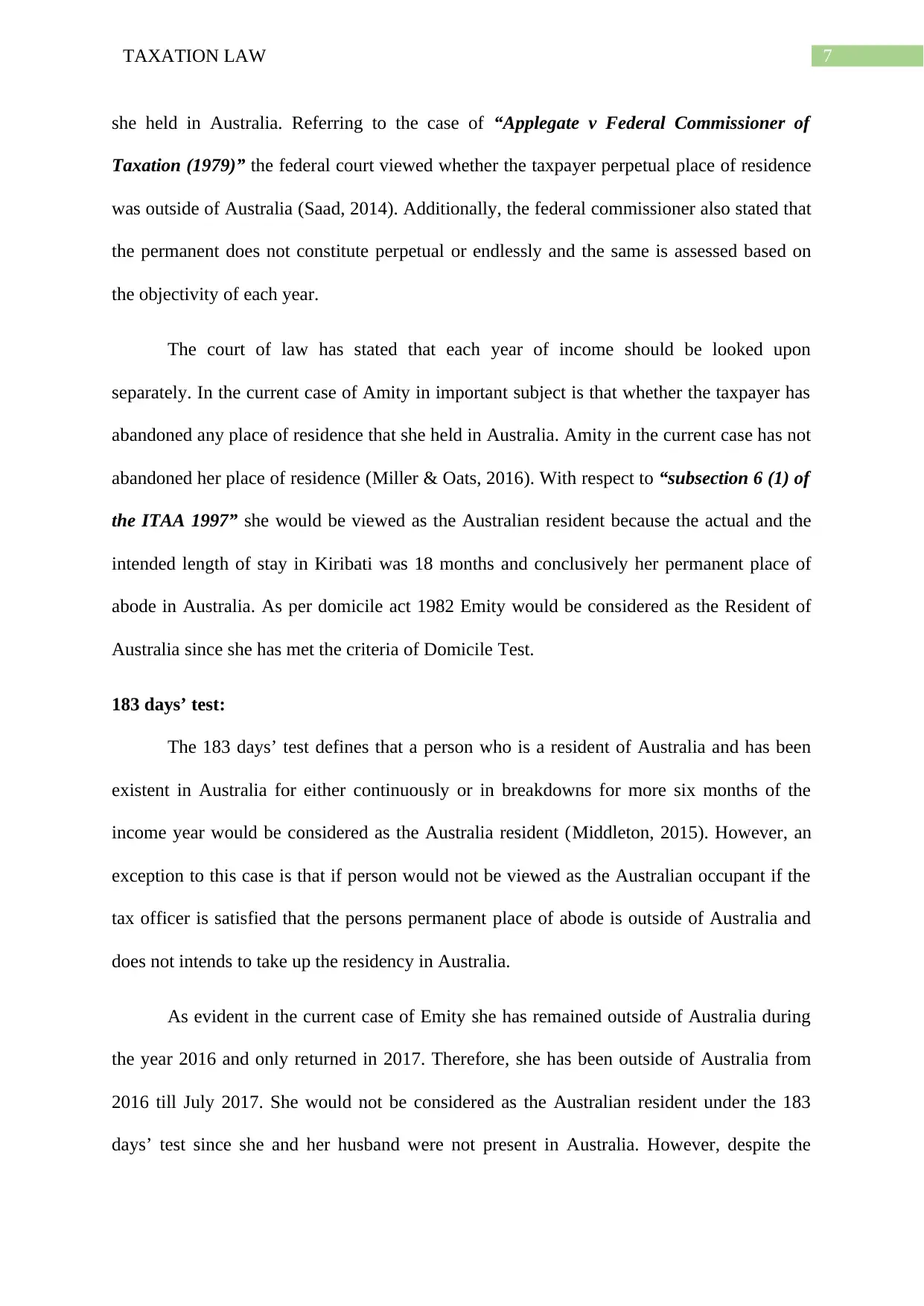
7TAXATION LAW
she held in Australia. Referring to the case of “Applegate v Federal Commissioner of
Taxation (1979)” the federal court viewed whether the taxpayer perpetual place of residence
was outside of Australia (Saad, 2014). Additionally, the federal commissioner also stated that
the permanent does not constitute perpetual or endlessly and the same is assessed based on
the objectivity of each year.
The court of law has stated that each year of income should be looked upon
separately. In the current case of Amity in important subject is that whether the taxpayer has
abandoned any place of residence that she held in Australia. Amity in the current case has not
abandoned her place of residence (Miller & Oats, 2016). With respect to “subsection 6 (1) of
the ITAA 1997” she would be viewed as the Australian resident because the actual and the
intended length of stay in Kiribati was 18 months and conclusively her permanent place of
abode in Australia. As per domicile act 1982 Emity would be considered as the Resident of
Australia since she has met the criteria of Domicile Test.
183 days’ test:
The 183 days’ test defines that a person who is a resident of Australia and has been
existent in Australia for either continuously or in breakdowns for more six months of the
income year would be considered as the Australia resident (Middleton, 2015). However, an
exception to this case is that if person would not be viewed as the Australian occupant if the
tax officer is satisfied that the persons permanent place of abode is outside of Australia and
does not intends to take up the residency in Australia.
As evident in the current case of Emity she has remained outside of Australia during
the year 2016 and only returned in 2017. Therefore, she has been outside of Australia from
2016 till July 2017. She would not be considered as the Australian resident under the 183
days’ test since she and her husband were not present in Australia. However, despite the
she held in Australia. Referring to the case of “Applegate v Federal Commissioner of
Taxation (1979)” the federal court viewed whether the taxpayer perpetual place of residence
was outside of Australia (Saad, 2014). Additionally, the federal commissioner also stated that
the permanent does not constitute perpetual or endlessly and the same is assessed based on
the objectivity of each year.
The court of law has stated that each year of income should be looked upon
separately. In the current case of Amity in important subject is that whether the taxpayer has
abandoned any place of residence that she held in Australia. Amity in the current case has not
abandoned her place of residence (Miller & Oats, 2016). With respect to “subsection 6 (1) of
the ITAA 1997” she would be viewed as the Australian resident because the actual and the
intended length of stay in Kiribati was 18 months and conclusively her permanent place of
abode in Australia. As per domicile act 1982 Emity would be considered as the Resident of
Australia since she has met the criteria of Domicile Test.
183 days’ test:
The 183 days’ test defines that a person who is a resident of Australia and has been
existent in Australia for either continuously or in breakdowns for more six months of the
income year would be considered as the Australia resident (Middleton, 2015). However, an
exception to this case is that if person would not be viewed as the Australian occupant if the
tax officer is satisfied that the persons permanent place of abode is outside of Australia and
does not intends to take up the residency in Australia.
As evident in the current case of Emity she has remained outside of Australia during
the year 2016 and only returned in 2017. Therefore, she has been outside of Australia from
2016 till July 2017. She would not be considered as the Australian resident under the 183
days’ test since she and her husband were not present in Australia. However, despite the
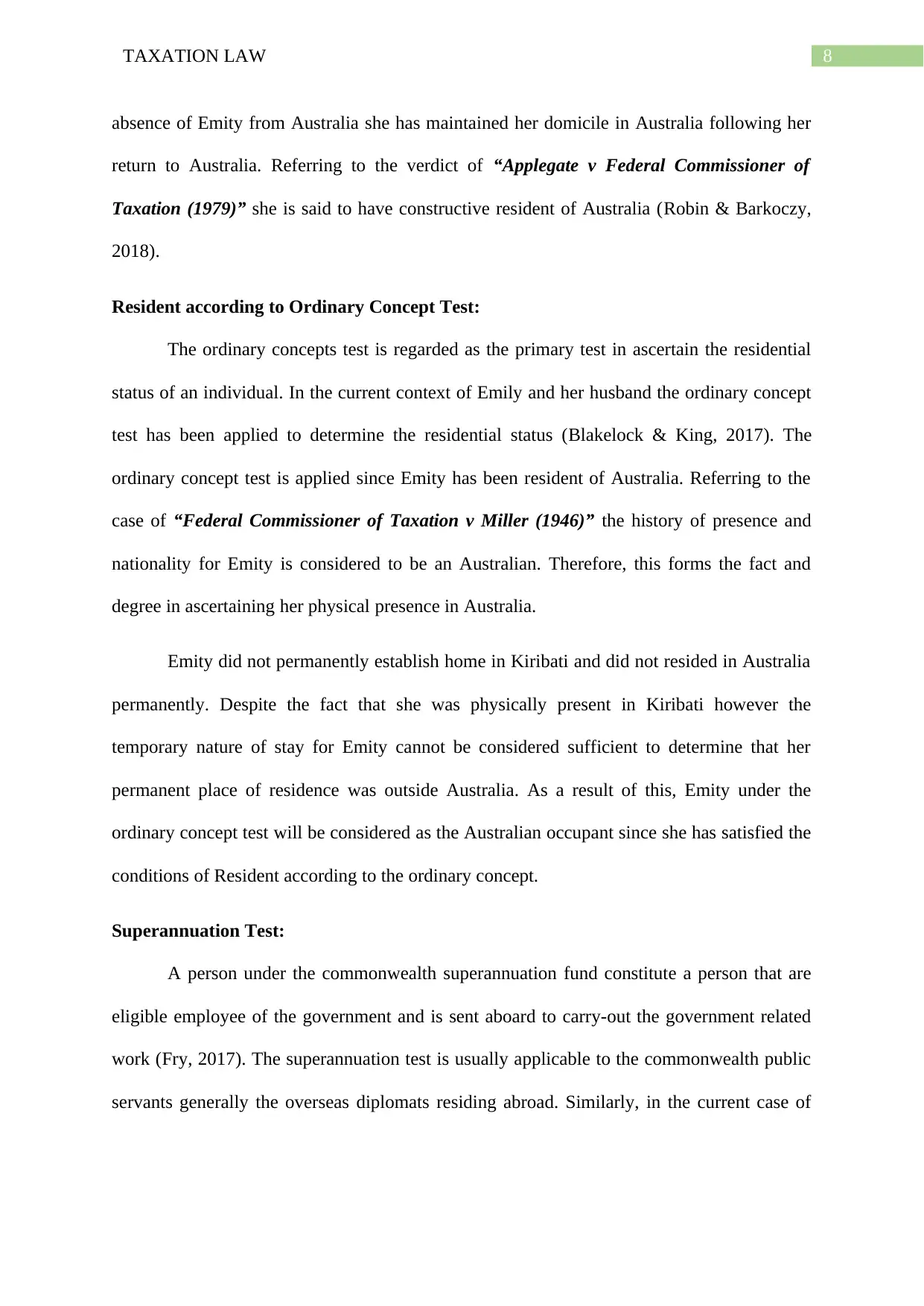
8TAXATION LAW
absence of Emity from Australia she has maintained her domicile in Australia following her
return to Australia. Referring to the verdict of “Applegate v Federal Commissioner of
Taxation (1979)” she is said to have constructive resident of Australia (Robin & Barkoczy,
2018).
Resident according to Ordinary Concept Test:
The ordinary concepts test is regarded as the primary test in ascertain the residential
status of an individual. In the current context of Emily and her husband the ordinary concept
test has been applied to determine the residential status (Blakelock & King, 2017). The
ordinary concept test is applied since Emity has been resident of Australia. Referring to the
case of “Federal Commissioner of Taxation v Miller (1946)” the history of presence and
nationality for Emity is considered to be an Australian. Therefore, this forms the fact and
degree in ascertaining her physical presence in Australia.
Emity did not permanently establish home in Kiribati and did not resided in Australia
permanently. Despite the fact that she was physically present in Kiribati however the
temporary nature of stay for Emity cannot be considered sufficient to determine that her
permanent place of residence was outside Australia. As a result of this, Emity under the
ordinary concept test will be considered as the Australian occupant since she has satisfied the
conditions of Resident according to the ordinary concept.
Superannuation Test:
A person under the commonwealth superannuation fund constitute a person that are
eligible employee of the government and is sent aboard to carry-out the government related
work (Fry, 2017). The superannuation test is usually applicable to the commonwealth public
servants generally the overseas diplomats residing abroad. Similarly, in the current case of
absence of Emity from Australia she has maintained her domicile in Australia following her
return to Australia. Referring to the verdict of “Applegate v Federal Commissioner of
Taxation (1979)” she is said to have constructive resident of Australia (Robin & Barkoczy,
2018).
Resident according to Ordinary Concept Test:
The ordinary concepts test is regarded as the primary test in ascertain the residential
status of an individual. In the current context of Emily and her husband the ordinary concept
test has been applied to determine the residential status (Blakelock & King, 2017). The
ordinary concept test is applied since Emity has been resident of Australia. Referring to the
case of “Federal Commissioner of Taxation v Miller (1946)” the history of presence and
nationality for Emity is considered to be an Australian. Therefore, this forms the fact and
degree in ascertaining her physical presence in Australia.
Emity did not permanently establish home in Kiribati and did not resided in Australia
permanently. Despite the fact that she was physically present in Kiribati however the
temporary nature of stay for Emity cannot be considered sufficient to determine that her
permanent place of residence was outside Australia. As a result of this, Emity under the
ordinary concept test will be considered as the Australian occupant since she has satisfied the
conditions of Resident according to the ordinary concept.
Superannuation Test:
A person under the commonwealth superannuation fund constitute a person that are
eligible employee of the government and is sent aboard to carry-out the government related
work (Fry, 2017). The superannuation test is usually applicable to the commonwealth public
servants generally the overseas diplomats residing abroad. Similarly, in the current case of
⊘ This is a preview!⊘
Do you want full access?
Subscribe today to unlock all pages.

Trusted by 1+ million students worldwide
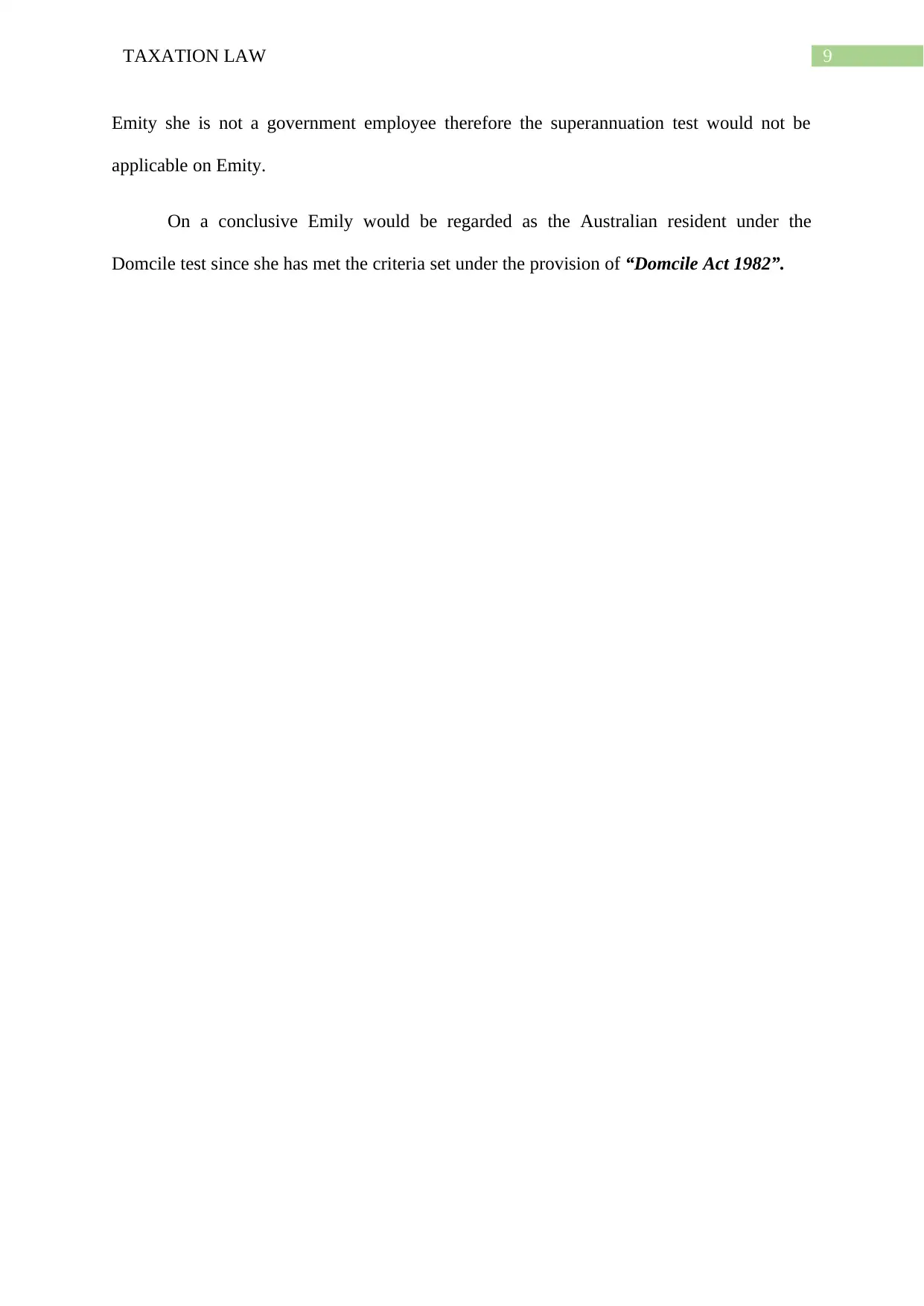
9TAXATION LAW
Emity she is not a government employee therefore the superannuation test would not be
applicable on Emity.
On a conclusive Emily would be regarded as the Australian resident under the
Domcile test since she has met the criteria set under the provision of “Domcile Act 1982”.
Emity she is not a government employee therefore the superannuation test would not be
applicable on Emity.
On a conclusive Emily would be regarded as the Australian resident under the
Domcile test since she has met the criteria set under the provision of “Domcile Act 1982”.
Paraphrase This Document
Need a fresh take? Get an instant paraphrase of this document with our AI Paraphraser
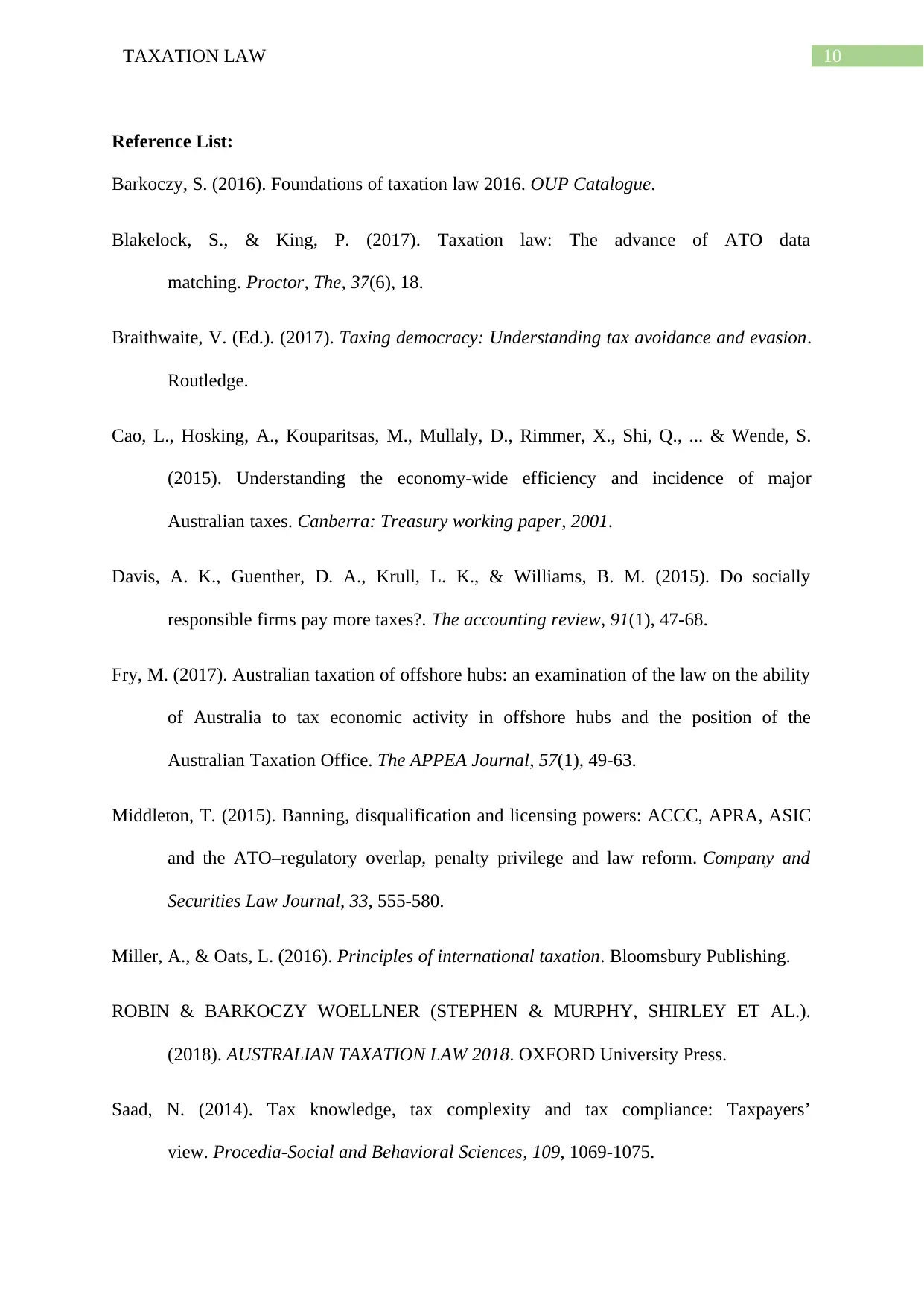
10TAXATION LAW
Reference List:
Barkoczy, S. (2016). Foundations of taxation law 2016. OUP Catalogue.
Blakelock, S., & King, P. (2017). Taxation law: The advance of ATO data
matching. Proctor, The, 37(6), 18.
Braithwaite, V. (Ed.). (2017). Taxing democracy: Understanding tax avoidance and evasion.
Routledge.
Cao, L., Hosking, A., Kouparitsas, M., Mullaly, D., Rimmer, X., Shi, Q., ... & Wende, S.
(2015). Understanding the economy-wide efficiency and incidence of major
Australian taxes. Canberra: Treasury working paper, 2001.
Davis, A. K., Guenther, D. A., Krull, L. K., & Williams, B. M. (2015). Do socially
responsible firms pay more taxes?. The accounting review, 91(1), 47-68.
Fry, M. (2017). Australian taxation of offshore hubs: an examination of the law on the ability
of Australia to tax economic activity in offshore hubs and the position of the
Australian Taxation Office. The APPEA Journal, 57(1), 49-63.
Middleton, T. (2015). Banning, disqualification and licensing powers: ACCC, APRA, ASIC
and the ATO–regulatory overlap, penalty privilege and law reform. Company and
Securities Law Journal, 33, 555-580.
Miller, A., & Oats, L. (2016). Principles of international taxation. Bloomsbury Publishing.
ROBIN & BARKOCZY WOELLNER (STEPHEN & MURPHY, SHIRLEY ET AL.).
(2018). AUSTRALIAN TAXATION LAW 2018. OXFORD University Press.
Saad, N. (2014). Tax knowledge, tax complexity and tax compliance: Taxpayers’
view. Procedia-Social and Behavioral Sciences, 109, 1069-1075.
Reference List:
Barkoczy, S. (2016). Foundations of taxation law 2016. OUP Catalogue.
Blakelock, S., & King, P. (2017). Taxation law: The advance of ATO data
matching. Proctor, The, 37(6), 18.
Braithwaite, V. (Ed.). (2017). Taxing democracy: Understanding tax avoidance and evasion.
Routledge.
Cao, L., Hosking, A., Kouparitsas, M., Mullaly, D., Rimmer, X., Shi, Q., ... & Wende, S.
(2015). Understanding the economy-wide efficiency and incidence of major
Australian taxes. Canberra: Treasury working paper, 2001.
Davis, A. K., Guenther, D. A., Krull, L. K., & Williams, B. M. (2015). Do socially
responsible firms pay more taxes?. The accounting review, 91(1), 47-68.
Fry, M. (2017). Australian taxation of offshore hubs: an examination of the law on the ability
of Australia to tax economic activity in offshore hubs and the position of the
Australian Taxation Office. The APPEA Journal, 57(1), 49-63.
Middleton, T. (2015). Banning, disqualification and licensing powers: ACCC, APRA, ASIC
and the ATO–regulatory overlap, penalty privilege and law reform. Company and
Securities Law Journal, 33, 555-580.
Miller, A., & Oats, L. (2016). Principles of international taxation. Bloomsbury Publishing.
ROBIN & BARKOCZY WOELLNER (STEPHEN & MURPHY, SHIRLEY ET AL.).
(2018). AUSTRALIAN TAXATION LAW 2018. OXFORD University Press.
Saad, N. (2014). Tax knowledge, tax complexity and tax compliance: Taxpayers’
view. Procedia-Social and Behavioral Sciences, 109, 1069-1075.
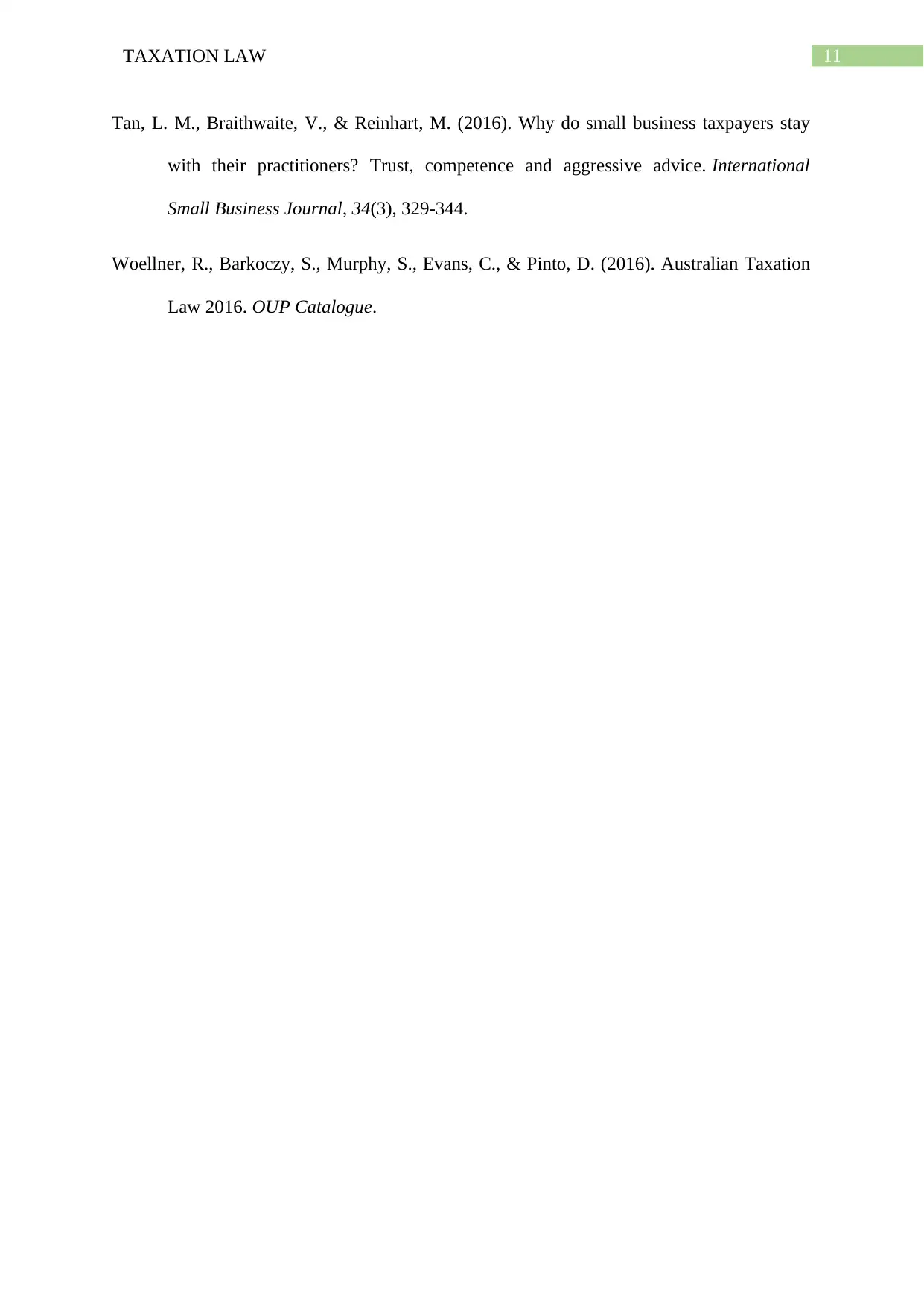
11TAXATION LAW
Tan, L. M., Braithwaite, V., & Reinhart, M. (2016). Why do small business taxpayers stay
with their practitioners? Trust, competence and aggressive advice. International
Small Business Journal, 34(3), 329-344.
Woellner, R., Barkoczy, S., Murphy, S., Evans, C., & Pinto, D. (2016). Australian Taxation
Law 2016. OUP Catalogue.
Tan, L. M., Braithwaite, V., & Reinhart, M. (2016). Why do small business taxpayers stay
with their practitioners? Trust, competence and aggressive advice. International
Small Business Journal, 34(3), 329-344.
Woellner, R., Barkoczy, S., Murphy, S., Evans, C., & Pinto, D. (2016). Australian Taxation
Law 2016. OUP Catalogue.
⊘ This is a preview!⊘
Do you want full access?
Subscribe today to unlock all pages.

Trusted by 1+ million students worldwide
1 out of 12
Related Documents
Your All-in-One AI-Powered Toolkit for Academic Success.
+13062052269
info@desklib.com
Available 24*7 on WhatsApp / Email
![[object Object]](/_next/static/media/star-bottom.7253800d.svg)
Unlock your academic potential
Copyright © 2020–2026 A2Z Services. All Rights Reserved. Developed and managed by ZUCOL.

![Taxation Law: Spriggs v Federal Commissioner of Taxation [2007]](/_next/image/?url=https%3A%2F%2Fdesklib.com%2Fmedia%2Fdocument%2Fpages%2Fspriggs-taxation-law-case-page-2.jpg&w=256&q=75)


